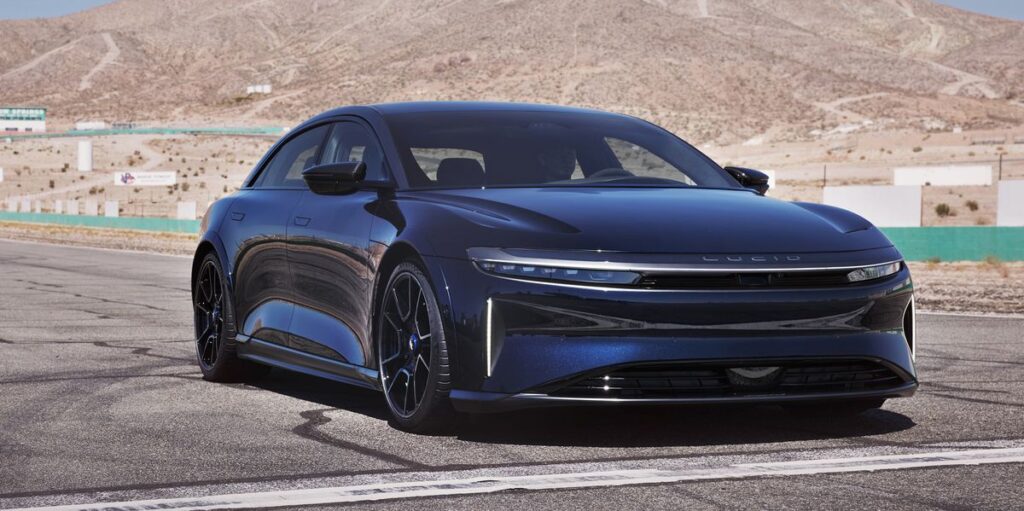2024 Lucid Air Sapphire Delivers Face-Punching Performance

Lucid’s lead chassis engineer punched me in the face. It wasn’t on purpose. I’d asked David Lickfold to video the speedometer while I tried the launch control in the 2024 Air Sapphire, and even knowing what to expect, he couldn’t fight the forces of physics. The phone hit my cheekbone with a hard crack, and the rest of the video is just me laughing and Lickfold apologizing. It earned me an afternoon with an icepack, but it’s a heck of a way to demonstrate the acceleration of Lucid Motors’ supersedan.
The Air Max
From the get-go, Lucid knew it wanted to offer an all-out version of the Air. The Air Sapphire aims to establish Sapphire as a performance sub-brand, like AMG or SVR, that could find its way to future models, like the upcoming Lucid Gravity SUV. This was quite an engineering ask. Even one of the most laid-back of Lucid’s cars, the dual-motor Air Pure, will get to 60 mph in 3.5 seconds, which is already high-performance territory for most machines. The Lucid team had to make Sapphire stand out with unheard-of performance numbers, but also daily driveability. They didn’t hold back. The three-motor Air Sapphire has 1234 peak horsepower, which is unleashed in its Track mode, and 1430 pound-feet of torque. It also has a brag-worthy claims of a top speed of 205 mph and a 0-to-60 time of 1.9 seconds, quick enough to knock the wind out of your chest and imprint your face on your phone screen.
Our test drive was more of a teaser—full testing and track time will come later this year, although we already ran a Sapphire development prototype around Virginia International Raceway. Even on a quick jaunt around the block, there were enough turns and straightaways to get some sense of how mad-cap bonkers the Sapphire is. Not only will it slam your head back fast enough to permanently emboss the Lucid bear logos from the headrest in the back of your skull, but it also turns and, thankfully, brakes, like a car half its size and weight. There’s a lot of wizardry going on under the Sapphire’s peaceful midnight blue metalflake to make it go and stop like it does. Everything from the traction-control system to the suspension knuckles have been tweaked or, in some cases, completely redesigned with massive horsepower management in mind.
Lucid Air Sapphire Design
The Sapphire’s exterior isn’t race-car shouty like some of its winged and tunneled GT competitors. “I think we’re all big fans of what I would call ‘high performance under the radar,'” said Derek Jenkins, senior VP of design for Lucid. Don’t look for a big swan-neck wing or hollowed-out body panels. If you want to spot the Sapphire, note the extended front splitter etched with the Sapphire name and the taller rear ducktail for improved stability at high speed. The Sapphire also does away with the glass canopy roof, replacing it with aluminum, which weighs less and lowers the center of gravity.
The whole car sits lower on larger, wider wheels and tires, 20 inches in the front and 21 in the rear, both wrapped in a just-for-Sapphire Michelin Pilot Sport 4S tire that uses a firmer compound in the center and a stickier rubber for the shoulders to optimize grip in the corners and traction in a straight line. The wheels are an open-spoke design specific to Sapphire and come with optional carbon-fiber aero covers. Although who would want to hide those massive carbon-ceramic rotors? They look like small planets orbiting behind the wheels—16.5-inch rotors with 10-piston calipers in the front and 15.4-inch rotors with four-piston calipers in the rear. Lickfold says that the team tested several variants of rotor before choosing discs from U.K.-based Surface Transforms, a company that specializes in carbon-ceramic made from longer strands of fiber for better thermal management. If you’re going to make a street car that runs a 9.0-second quarter-mile time, it’s a good feature if it can slow down at the finish line. Repeatedly.
Inside, the Sapphire retains the large screen and minimalist layout of other Lucid Air models but adds bolstering to the front seats and some sporty flourishes, such as blue stitching on the dark-gray Alcantara seats and door panels. The same material covers the headliner, which would make the interior a dark, mousey cave in a smaller car, but looks lush in the Lucid’s large cabin. Unlike some high-performance variants, Lucid decided against de-contenting the interior for weight savings, so the sport seats still offer heating, ventilation, and massage functions. The rear seat remains fully padded for passengers. Jenkins says that while there are growing numbers of EV track clubs, the majority of buyers for the Sapphire are looking for a daily flex, not an all-out racer, so maintaining comfort and utility was crucial to a successful design.
The Sapphire’s Engineering Changes
The majority of changes in the Sapphire are really under the Sapphire, in its third motor, retuned suspension, and unnervingly quick chassis software. With one motor up front and two in the rear, the Sapphire needed to be able to control power delivery both front to rear and, in the back, left to right. Putting down more than 1000 horsepower, even to wide, sticky tires, requires ultraquick adjustments. Chassis engineer Lickfold says the available vendor-supplied traction-control systems could react every 20 milliseconds. The Sapphire’s in-house central vehicle control unit measures and responds in one millisecond. “It’s faster than humans can perceive,” he said, right before instructing me to floor the car in the apex of a left-hand turn. I did, and there was barely a chirp as the big sedan leaped forward into the appropriate lane. It’s unnatural. Drive this car for a few weeks, and it would be hard to go back to anything else again.
The new software isn’t just for terrifying passengers on corner exit. It can also be used to adjust the Sapphire’s handling characteristics, slowing or speeding the rear wheels independently of each other to mimic the sedate turning radius of a long luxury car or the sharp reactions of a rear-wheel-drive V-8 in a short-wheelbase vehicle. In addition to the existing models’ Smooth and Swift drive modes, there’s a Sapphire mode that feeds in more of the available 1234 horses, and a Track mode that relaxes the traction management and tightens up steering and suspension. Track mode opens a sub-menu that includes Dragstrip, Hot Lap, and Endurance programs, which condition the battery and energy management to offer the most for a short time, or enough to go a longer session. Think of them as Qualifying and Track Day settings.
Air Sapphire Range and Price
With such a short stint behind the wheel, we barely put a dent in the Sapphire’s promised 427 miles of range. The Sapphire uses a 118.0-kWh battery, and with a 900-volt architecture, it should be able to recharge at rates up to 300 kW at a DC fast-charger. The Sapphire is on sale now, with a starting price of $250,575, and deliveries should begin in September 2023. In the EV horsepower wars, Lucid may have just thrown a knockout punch.
Senior Editor, Features
Like a sleeper agent activated late in the game, Elana Scherr didn’t know her calling at a young age. Like many girls, she planned to be a vet-astronaut-artist, and came closest to that last one by attending UCLA art school. She painted images of cars, but did not own one. Elana reluctantly got a driver’s license at age 21 and discovered that she not only loved cars and wanted to drive them, but that other people loved cars and wanted to read about them, which meant somebody had to write about them. Since receiving activation codes, Elana has written for numerous car magazines and websites, covering classics, car culture, technology, motorsports, and new-car reviews.




